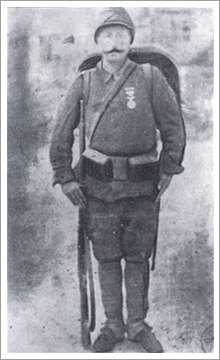Bigalı Mehmet Çavuş
Bigalı Mehmet Çavuş (* 1878 in Plovdiv ; † February 3, 1964 in Bahçeli near Biga ) was an Ottoman soldier with the rank of Çavuş ( sergeant ) who fought at the Battle of Gallipoli in World War I. His name became the eponym "Mehmetçik" (Eng. "Little Mehmet"), which is used for the Ottoman soldiers.
Life
Bigalı Mehmet Çavuş was born in 1878 in Plovdiv, Bulgaria, which was part of the Ottoman Empire at the time. During the Russo-Ottoman War in 1877/78, the Russians took the city at the Battle of Plovdiv and the family emigrated to Anatolia in the village of Bahçeli near Biga .
Mehmet Çavuş already fought in the Balkan Wars and the Battle of Gallipoli . He was stationed on the beach in front of the fortress Sadd al-Bahr (in Turkish Seddülbahir Kalesi ) and the artillery batteries of the peninsula. There he fought against the landing of the British troops.
At 2:45 pm local time on March 4, 1915, five warships and seven Allied torpedo boats bombed the fortress. 60 British soldiers landed in three boats under the gunfire of Mitrailleusen to take the Ottoman fortress and thus ensure a safe passage through the Dardanelles . Although the Ottomans withdrew the artillery, they left a small force led by Mehmet Çavuş at the fortress. The group was part of the 27th regiment of the 10th Division under the command of Colonel Halil Sami Bey , who was responsible for the defense of the region. The 30 Turkish soldiers were armed only with rifles and grenades.
During the three-hour battle, the Ottomans constantly changed their position in the fortress in order to simulate a larger number of fighters. No more Allied troops landed on the beach. During the fighting, Mehmet's rifle barrel broke. He threw the broken rifle at the enemy and attacked them with stones. Mehmet Çavuş was injured in the head and right chest. When the comrades saw that Mehmet Çavuş was fighting the enemy only with stones, they gave up cover. The opposing troops gave up and retreated to the ships when the Ottomans approached with bayonets. When the Ottomans advanced into the fortress that evening, six Ottoman soldiers were dead, 13 wounded and only 12 were able to continue fighting.
Mithat Atabay, commander of the 19th division in Haraptepe , wrote a report to the commander of the Dardanelles fortresses, Cevat Pasha , recommending an award for Mehmet Çavuş. The deputy commander in chief Enver Pascha visited Mehmet Çavuş in the military hospital in Çanakkale and awarded him the Ottoman War Medal Iron Crescent .
Mehmet Çavuş served in the army for a total of 16 years. After the end of his military career, he returned to his village. He refused a war pension. He died at the age of 86 on February 3, 1964 and was buried next to his wife.
Honors
It is believed that "Mehmetçik" as a synonym for Ottoman soldiers can be traced back to his name. In 2017 his grave was converted into a marble monumental grave and provided with an explanatory information board.
Individual evidence
- ↑ a b c d e f g Seddülbahir Kahramanı Bigalı Mehmet Çavuş , Biga City Council, accessed on April 10, 2018
- ↑ a b Burak Gezen, Mustafa Suiçmez: Seddülbahir Kalesi'ne dolgulu koruma , Hürriyet October 2, 2017
- ↑ a b c Fikriye Susam Uyar: Bigalı Mehmet Çavuş Çanakkale'de 30 Kişiyle Destan Yazdı , Haberler, March 15, 2013
- ↑ a b c d Safiye Tarı Güner: Bigalı Mehmet Çavuş mezarı başında anıldı , Hürriyet , February 4, 2017
- ↑ 4 Mart 1915 Çıkarması , Kültür ve Turizm Bakanlığı - Çanakkale Halk Kütüphanesi
- ↑ a b c Mehmetçik'in isim babasına anıt mezar , Çanakkale Olay, May 22, 2017
- ↑ a b Seddülbahir Kahramanı Bigalı mehmet Çavuş Mezarı Başında Anıldı , Milliyet , March 13, 2016
- ↑ a b Safiye Tarı Güner: İlker Başbuğ, Bigalı Mehmet Çavuş'un mezarını ziyaret etti , Hürriyet , January 19, 2017
- ^ Nicole David: Ottoman Infantryman 1914-18 , Osprey Publishing, 2010, ISBN 978-1-84603-506-7 , p. 38.
| personal data | |
|---|---|
| SURNAME | Çavuş, Bigalı Mehmet |
| BRIEF DESCRIPTION | Ottoman-Turkish soldier |
| DATE OF BIRTH | 1878 |
| PLACE OF BIRTH | Plovdiv |
| DATE OF DEATH | 3rd February 1964 |
| Place of death | Bahçeli at Biga |

